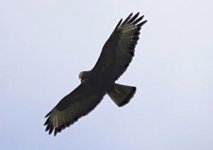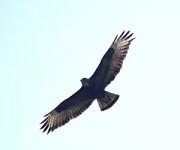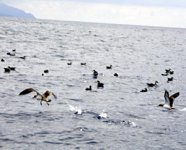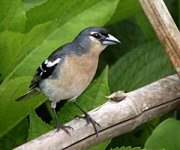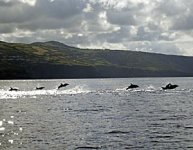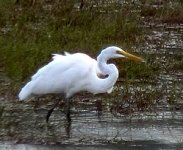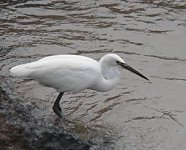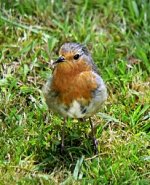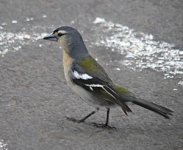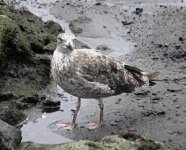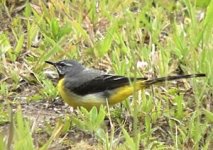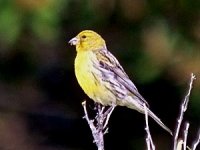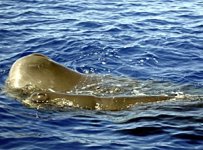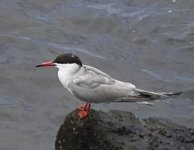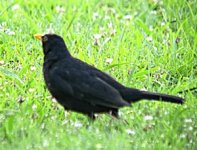Macswede
Macswede
Birding was not our main reason for choosing the Azores as a honeymoon destination – that had more to do with a schools’ cruise to Lisbon, Ceuta (Spanish Morocco), Madeira and the Azores taken when I was 15 years old. It was a fantastic adventure for a Scottish teenager who had only previously visited one foreign country, England. Even at the time I didn’t really feel that England counted. When my fiancée and I were discussing where to go on our honeymoon, (places as diverse as Iceland and the South of France were briefly considered) I spoke enthusiastically about the remembered beauty of Madeira and the Azores. I think we chose the Azores because my fiancée was more curious about them and because we had heard the Madeira had become rather commercialised. I did make a quick check on the Internet to ensure that there would be no repeat of the (purely from a birding point of view) disastrous holiday on Malta where I discovered to my great disappointment that all birds apart from Maltese sparrows and tame pigeons had been slaughtered or driven away from the island. If you can imagine an island without seabirds that’s Malta. And yes I do know it’s a birding paradise during migration seasons but we were there in mid-July.
It was a promising start to our honeymoon birding that the islands are in fact named after a bird, Buteo buteo rothschildi, an endemic subspecies of the Common Buzzard. This being the case one might expect the name Azores (Açores) to be derived from the Portuguese word for Buzzard but no, it is in fact derived from the Portuguese word for Goshawk which is what the sailors who discovered the islands in the 15th century thought they were. “Oh look,” they may have said, “Goshawks just like at home in Portugal.” Well they were sailors and explorers, not ornithologists. Of course nowadays such misunderstandings have been cleared up. Well no, not exactly. I saw a picture of a Buzzard in an official brochure with the caption Kite underneath. I took this up with a young Portuguese ornithologist, Ricardo, during a day’s guided birding. If you use the Portuguese word for Buzzard with the locals, we were told, they won’t know what you’re talking about but mention the word Kite and their eyes light up in recognition of the cherished symbol of the Azores. Not that the birds care. They can revel in their position as the sole species of raptor in an island group that is also devoid of corvids.
On arrival in Capelas in the north-west of the main island, San Miguel, 4 things quickly became apparent: 1 we weren’t going to have time to visit any of the islands in the group during our honeymoon: 2 the breeding season occurs later in the Azores than in Sweden (we left a largely silent Sweden to be greeted by birdsong and feverish feathered activity); 3 there is no need to fear a decline in the House Sparrow population of the Azores; 4 we had one of the best bedroom windows in the islands.
Ricardo later informed us that sparrows were introduced the islands as late as the 1960s. He thought there were only 2 pairs. From the point of view of the sparrows the introduction has been a huge success. The locals dislike them though because they have driven the Canaries away from the villages. I can sympathise with them. It can’t be pleasant to have the sweet song of Canaries replaced by the cacophonous chirping of Passer domesticus.
We stayed in a self-catering bungalow at the end of the complex. The bedroom faced a garden which had become neglected and been allowed to grow wild. At the front of the bungalow bird species were limited to House Sparrows, Robins and Blackbirds (with fleeting visits from a Canary and a Goldfinch) but from the bedroom window we had great views of the Buzzards. On one occasion I saw three birds and, as I watched, two of them linked talons and tumbled earthwards, something I had not seen previously. Within the first couple of days I had also observed Blackcaps, Goldcrests, Starlings and Chaffinches (all endemic subspecies), Canaries, a Grey Wagtail perched in a tree (a subspecies also found on Madeira) and Greenfinches (a Mediterranean subspecies introduced, presumably as cage birds along with the Goldfinches.
The Azores are crossed by both American and European migration routes so there are opportunities to see a lot of interesting and unusual birds if you are there at the right time. We weren’t but we did see three vagrants during our stay: a Little Egret, a Turnstone and a Great White Egret.
The Azores is also a great place for whale-watching. We were too late to see migrating Blue Whales and Humpbacks but we did see 3 species of dolphin and several Sperm Whales including a baby that appeared to adopt our boat as a surrogate while its mother was on a deep dive. Out at sea there were huge numbers of Cory’s Shearwaters and a lot of Yellow-legged Gulls. Inshore there were a fair number of Common Terns.
The only new species we saw on our day’s guided birding was a Common Moorhen but we did get great view of Goldcrests (Azoricus) even if I didn’t manage to take a single recognisable picture. On the other we met some really nice people and I got a tip on where to see the Great White Egret from Roy, a very nice Englishman. Ricardo also invited me to his office in Nordeste near the area where the Azores Bullfinches or Priolos, as Riccardo preferred to call them, are most common (a relative term as there are only about 300 birds in existence). Among other things Ricardo works on an EU project to protect and learn more about the species (or subspecies – apparently opinions are divided). When we arrived we were told they had netted a couple of birds that morning and attached tiny transmitters to them (the equipment was lent to them by the RSPB but they intend to buy their own if the pilot test is a success). He was going to travel up to the mountains to get fix on the birds and invited us to join him. Unfortunately we didn’t see any Bullfinches though I did hear 2 calling from thick forestation on the slopes further down the mountain and the views were simply breathtaking. We intended to drive along a road recommended by Ricardo on our final day with the hire car but the road we planned to take was closed and it was too late to choose another route. We did have an incredible honeymoon though and managed to see some great birds too.
The Robin is not classed as a subspecies but I thought it looked quite different from the ones I’ve seen in Britain and Sweden. I said as much to Riccardo who replied that they weren’t introduced to the Azores so they’ve had as much time to evolve into a subspecies as all the other non-introduced species. He suggested the Robin might have been overlooked when the application for subspecies status was made. I’ve a feeling he might have been joking though.
I couldn't see any difference between the Wood Pigeons (azorica), the Starlings (granti) and the ones I’m used to but I didn’t really get a chance to study them closely.
The Blackbirds appeared larger than ours with bigger beaks. My wife also thought the males looked blacker. The beaks and eye-rings were more orange.
I have no idea whether the 3 vagrants are American or Eurasian birds and don’t know whether it’s possible to tell from the pictures. Any ideas?
All the photos are my own except for the Dolphin and Sperm Whale pictures, the Cory Shearwater picture and the adult Yellow-legged Gull (atlantis) which are all courtesy of my wife.
I’ve given the photos the Latin names for what I think the birds are. Please let me know if you disagree with any.
Graham
It was a promising start to our honeymoon birding that the islands are in fact named after a bird, Buteo buteo rothschildi, an endemic subspecies of the Common Buzzard. This being the case one might expect the name Azores (Açores) to be derived from the Portuguese word for Buzzard but no, it is in fact derived from the Portuguese word for Goshawk which is what the sailors who discovered the islands in the 15th century thought they were. “Oh look,” they may have said, “Goshawks just like at home in Portugal.” Well they were sailors and explorers, not ornithologists. Of course nowadays such misunderstandings have been cleared up. Well no, not exactly. I saw a picture of a Buzzard in an official brochure with the caption Kite underneath. I took this up with a young Portuguese ornithologist, Ricardo, during a day’s guided birding. If you use the Portuguese word for Buzzard with the locals, we were told, they won’t know what you’re talking about but mention the word Kite and their eyes light up in recognition of the cherished symbol of the Azores. Not that the birds care. They can revel in their position as the sole species of raptor in an island group that is also devoid of corvids.
On arrival in Capelas in the north-west of the main island, San Miguel, 4 things quickly became apparent: 1 we weren’t going to have time to visit any of the islands in the group during our honeymoon: 2 the breeding season occurs later in the Azores than in Sweden (we left a largely silent Sweden to be greeted by birdsong and feverish feathered activity); 3 there is no need to fear a decline in the House Sparrow population of the Azores; 4 we had one of the best bedroom windows in the islands.
Ricardo later informed us that sparrows were introduced the islands as late as the 1960s. He thought there were only 2 pairs. From the point of view of the sparrows the introduction has been a huge success. The locals dislike them though because they have driven the Canaries away from the villages. I can sympathise with them. It can’t be pleasant to have the sweet song of Canaries replaced by the cacophonous chirping of Passer domesticus.
We stayed in a self-catering bungalow at the end of the complex. The bedroom faced a garden which had become neglected and been allowed to grow wild. At the front of the bungalow bird species were limited to House Sparrows, Robins and Blackbirds (with fleeting visits from a Canary and a Goldfinch) but from the bedroom window we had great views of the Buzzards. On one occasion I saw three birds and, as I watched, two of them linked talons and tumbled earthwards, something I had not seen previously. Within the first couple of days I had also observed Blackcaps, Goldcrests, Starlings and Chaffinches (all endemic subspecies), Canaries, a Grey Wagtail perched in a tree (a subspecies also found on Madeira) and Greenfinches (a Mediterranean subspecies introduced, presumably as cage birds along with the Goldfinches.
The Azores are crossed by both American and European migration routes so there are opportunities to see a lot of interesting and unusual birds if you are there at the right time. We weren’t but we did see three vagrants during our stay: a Little Egret, a Turnstone and a Great White Egret.
The Azores is also a great place for whale-watching. We were too late to see migrating Blue Whales and Humpbacks but we did see 3 species of dolphin and several Sperm Whales including a baby that appeared to adopt our boat as a surrogate while its mother was on a deep dive. Out at sea there were huge numbers of Cory’s Shearwaters and a lot of Yellow-legged Gulls. Inshore there were a fair number of Common Terns.
The only new species we saw on our day’s guided birding was a Common Moorhen but we did get great view of Goldcrests (Azoricus) even if I didn’t manage to take a single recognisable picture. On the other we met some really nice people and I got a tip on where to see the Great White Egret from Roy, a very nice Englishman. Ricardo also invited me to his office in Nordeste near the area where the Azores Bullfinches or Priolos, as Riccardo preferred to call them, are most common (a relative term as there are only about 300 birds in existence). Among other things Ricardo works on an EU project to protect and learn more about the species (or subspecies – apparently opinions are divided). When we arrived we were told they had netted a couple of birds that morning and attached tiny transmitters to them (the equipment was lent to them by the RSPB but they intend to buy their own if the pilot test is a success). He was going to travel up to the mountains to get fix on the birds and invited us to join him. Unfortunately we didn’t see any Bullfinches though I did hear 2 calling from thick forestation on the slopes further down the mountain and the views were simply breathtaking. We intended to drive along a road recommended by Ricardo on our final day with the hire car but the road we planned to take was closed and it was too late to choose another route. We did have an incredible honeymoon though and managed to see some great birds too.
The Robin is not classed as a subspecies but I thought it looked quite different from the ones I’ve seen in Britain and Sweden. I said as much to Riccardo who replied that they weren’t introduced to the Azores so they’ve had as much time to evolve into a subspecies as all the other non-introduced species. He suggested the Robin might have been overlooked when the application for subspecies status was made. I’ve a feeling he might have been joking though.
I couldn't see any difference between the Wood Pigeons (azorica), the Starlings (granti) and the ones I’m used to but I didn’t really get a chance to study them closely.
The Blackbirds appeared larger than ours with bigger beaks. My wife also thought the males looked blacker. The beaks and eye-rings were more orange.
I have no idea whether the 3 vagrants are American or Eurasian birds and don’t know whether it’s possible to tell from the pictures. Any ideas?
All the photos are my own except for the Dolphin and Sperm Whale pictures, the Cory Shearwater picture and the adult Yellow-legged Gull (atlantis) which are all courtesy of my wife.
I’ve given the photos the Latin names for what I think the birds are. Please let me know if you disagree with any.
Graham
Attachments
Last edited:




